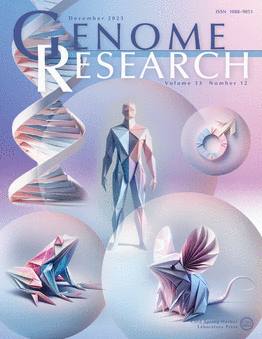Xist上游缺失导致Xist和常染色体基因表达失调
IF 5.5
2区 生物学
Q1 BIOCHEMISTRY & MOLECULAR BIOLOGY
引用次数: 0
摘要
Xist长链非编码RNA是x染色体失活(XCI)过程的主要调控因子。Xist由非活性X表达,并包裹非活性X以促进XCI。在XCI维持的背景下,对Xist表达的顺式调控仍然知之甚少。在这里,我们探索了位于t6和Jpx之间的Xist上游序列(约6 kb)在小鼠胚胎外内胚层干细胞(XEN)中Xist和XCI的调控作用,Xist和XCI代表了印迹XCI的维持阶段。在这里,我们发现在不活跃的X中删除这个Xist上游序列会导致Xist表达上调,并伴随着Xist云的扩散。值得注意的是,我们发现除了H2AK119ub外,分散的Xist核中H3K27me3、H4K20me1和MacroH2A等抑制标记的富集缺失。然而,x连锁基因保持沉默,尽管Xist分散和抑制标记的富集丧失。值得注意的是,我们发现许多常染色体基因,包括内聚蛋白Rad21,在xist -上游缺失的细胞中失调。此外,我们证明了Xist-上游缺失导致Xist位点与其上游正调节因子Ftx以及非活性X和常染色体之间的拓扑接触发生改变。最后,我们展示了建筑蛋白CTCF/RAD21在全基因组范围内的占用变化,包括非活性X的许多位点,如Xist上游区域和Firre位点,这对维持非活性X构象至关重要。综上所述,我们证明了Xist上游序列在XCI之外的基因组调控中具有多方面的作用。本文章由计算机程序翻译,如有差异,请以英文原文为准。
Xist upstream deletion leads to dysregulation of Xist and autosomal gene expression
Xist long noncoding RNA is the master regulator of the X-Chromosome inactivation (XCI) process. Xist is expressed from the inactive X and coats the inactive X to facilitate XCI. Cis-regulation of Xist expression remains poorly understood in the context of maintenance of XCI. Here, we have explored the role of the Xist upstream sequences (∼6 kb) lying between Tsix and Jpx in the regulation of Xist and XCI in mouse extra-embryonic endoderm stem cells (XEN), which represent the maintenance phase of imprinted XCI. Here, we show that the deletion of this Xist upstream sequence in the inactive X leads to the upregulation of Xist expression accompanied by the dispersal of the Xist cloud. Notably, we find the loss of enrichment of repressive marks such as H3K27me3, H4K20me1, and MacroH2A, except that of H2AK119ub, in dispersed Xist nuclei. However, X-linked genes remain silent despite Xist dispersal and loss of enrichment of repressive marks. Notably, we find that many autosomal genes, including cohesin Rad21, are dysregulated in Xist-upstream-deleted cells. Additionally, we demonstrate that Xist-upstream deletion leads to alterations of topological contacts of the Xist locus with its upstream positive regulator Ftx and across the inactive X and autosomes. Finally, we show genome-wide alterations of the occupancy of architectural proteins CTCF/RAD21, including at many loci of the inactive X such as the Xist upstream regions and the Firre locus, which is critical for maintaining inactive X conformation. Taken together, we demonstrate that the Xist upstream sequence imparts a multifaceted role in genome regulation beyond the XCI.
求助全文
通过发布文献求助,成功后即可免费获取论文全文。
去求助
来源期刊

Genome research
生物-生化与分子生物学
CiteScore
12.40
自引率
1.40%
发文量
140
审稿时长
6 months
期刊介绍:
Launched in 1995, Genome Research is an international, continuously published, peer-reviewed journal that focuses on research that provides novel insights into the genome biology of all organisms, including advances in genomic medicine.
Among the topics considered by the journal are genome structure and function, comparative genomics, molecular evolution, genome-scale quantitative and population genetics, proteomics, epigenomics, and systems biology. The journal also features exciting gene discoveries and reports of cutting-edge computational biology and high-throughput methodologies.
New data in these areas are published as research papers, or methods and resource reports that provide novel information on technologies or tools that will be of interest to a broad readership. Complete data sets are presented electronically on the journal''s web site where appropriate. The journal also provides Reviews, Perspectives, and Insight/Outlook articles, which present commentary on the latest advances published both here and elsewhere, placing such progress in its broader biological context.
 求助内容:
求助内容: 应助结果提醒方式:
应助结果提醒方式:


